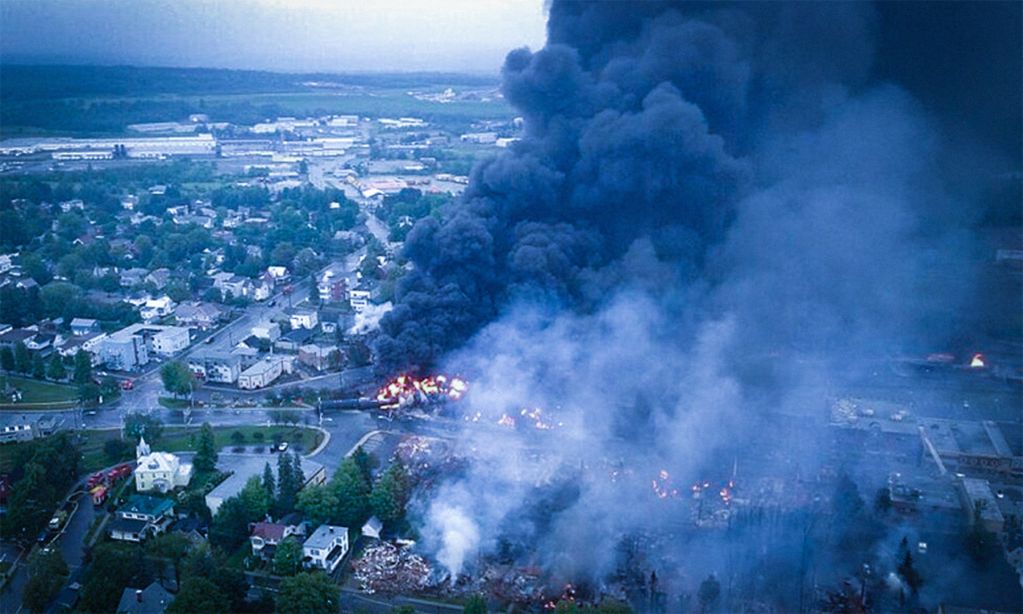On July 6, 2013, a runaway train carrying 72 tank cars loaded with volatile Bakken shale oil derailed and exploded in the centre of Lac-Mégantic, a small town in southeastern Quebec. It killed 47 people, orphaned 26 children, spilled a record six million litres of oil, and incinerated the town centre.
It was the worst rail disaster in more than a century—a catastrophe described by the editor of the local weekly newspaper as “a chain of explosions and the sound of whistling gas escaping from everywhere: the vomiting bowels of hell.”
Ten years later, the factors that led to the Lac-Mégantic tragedy have not been addressed. It has its roots in neoliberal tenets of deregulation.
I began my research into what led to the disaster shortly after it happened. My first CCPA report was published in the fall of 2013, with two more in 2014. I was deeply motivated to seek the truth about what really happened—and why—after learning my colleague Diane lost three members of her extended family in the inferno. The Bégnoches family lost their daughter Talitha Coumi and two granddaughters, Alyssa and Bianka.
I spent 2016 as a visiting fellow at the University of Ottawa Law Faculty, teaching and lecturing on issues related to the disaster. My book, The Lac-Mégantic Rail Disaster: Public Betrayal Justice Denied, was released in 2018, after which I travelled across Canada and the U.S. sharing the story. I was warmly received at the 2019 launch of the French edition of my book, Enquête sur la catastrophe de Lac-Mégantic: Quand les pouvoirs publiques déraillent, at the rebuilt Musi-Café club, where most of the victims died.
Lac-Mégantic was the violent consequence of a four decades-long trajectory of mutually reinforcing policies: deregulation, privatization, tax cuts, austerity—which systematically eroded transportation safety protections. It entrenched the power relationship between railway corporations, with their formidable lobbying eco-system, in concert with government enablers. What is referred to as regulatory capture has also infected a wide swath of other industries.
Austerity reinforced a vicious cycle, where gutted regulatory resources increased pressure to offload responsibility to companies: self-regulation. It reinforced companies’ power to block, delay, dilute, reverse, or remove regulations that adversely affected short-term profit and shareholder value.
In the years leading up to the disaster, the railway/petroleum lobby blocked regulations proposed to address the ballooning danger as unnecessary. The volume of oil transported by rail in Canada soared from 500 tank cars in 2009 to 160,000 in 2013. Huge volumes were being hauled through Lac-Mégantic by a company with a poor safety record, on a poorly maintained track, with a single operator, in tank cars designed for carrying corn oil, with negligible oversight and enforcement: an accident waiting to happen.
Disaster aftershocks
The Lac-Mégantic community has been plagued by a legacy of economic, health, and environmental after-shocks.
Shortly after the disaster, victims’ families were exploited by ambulance chasers promising them major compensation in U.S. courts.
Disaster capitalists, including private contractors, financiers, and allied local politicians, oversaw the destruction of large portions of the town that had not been contaminated, despite opposition from most residents.
York University Professor Liette Gilbert, who grew up in the adjacent town of Nantes, where the train ran away, has written about the creative destruction that shaped the reconstruction effort in Lac-Mégantic, describing how those in control manipulated the language of urgency, risk and resilience to impose their agenda on a traumatized community, including residents who were summarily evicted from their homes.
Trains carrying dangerous goods continue to rumble through the town, whistles screaming day and night. These much longer and heavier trains still descend the steep slope and go around the sharp curve where the fateful train derailed. They still carry dangerous goods in standard or slightly upgraded DOT-111 tank cars—the kind that derailed and spilled on that tragic night. Unit oil trains are no longer running through the town, at least for now.
The fear of another derailment keeps residents on edge. On April 15, 2023, a CP freight train (its new name is Canadian Pacific Kansas Southern) carrying toxic chemicals derailed and caught fire in Northern Maine. This same train had earlier passed through Lac-Mégantic, only 56 km from the crash.
As far as I can determine, neither the provincial or federal government have conducted (or at least made public) studies on the health effects of people’s exposure to the toxic chemicals that spilled into the air, water, and soil that night—whether there has been a disproportionate level of cancer, asthma, birth defects, or more.
Construction of the long-promised bypass around the town still has not begun. The bypass was supposed to be a step toward healing the community. Transport Canada has bungled the issue from the outset. The chosen route has sharply divided the community. Opposition to this route—the one preferred by Canadian Pacific, which will own the government-financed bypass upon completion—means still further delay. Those whose lands will be appropriated are seen as the latest victims of the disaster. Completion of the bypass is years away.
The ongoing setbacks have contributed to a state of despair and resignation among large segments of the population; a belief that nothing can be done. It is also a story of citizens who continue to fight for safety and justice; who fight to uncover the whole truth surrounding the disaster; who fight to keep its memory alive; who refuse to give up.
Who has been held accountable?
Three front-line workers were criminally charged and acquitted. No corporate executives, owners, or directors have been held legally liable.
No senior official, politician, corporate executive, or director has admitted their role and responsibility for the tragedy. Successive governments have refused demands by the community to establish an independent commission of inquiry.
Civil suits, including a class action lawsuit filed on behalf of town residents, resulted in a 2015 plea deal with 24 defendants, including the federal government, contributing to a $460 million settlement fund protecting them from further charges.
A lone defendant, Canadian Pacific Railway—the company contracted to transport the cargo from North Dakota to the Irving refinery in Saint John—refused to settle. CP also managed, on a technicality, to evade accountability in a wrongful death suit filed in U.S. court.
After repeated CP-instigated trial delays, the Québec Superior Court ruled in December 2022 that CP could not be held liable for damages suffered by the Lac-Mégantic victims. It was a blatant example of a flawed legal system wherein major Canadian railways effectively determine the laws, rules, and regulations, and escape liability in the event of a disaster. Another setback in the fight for justice. The plaintiffs have appealed the court ruling.
Compare CP’s refusal to compensate victims with the fact that it purchased a major U.S. railway, Kansas City Southern, for US$31 billion in 2020. Compare it with the record compensation paid to CP’s senior executives. CEO Keith Creel’s compensation in 2021 was the 6th highest in Canada, at $26.7 million. Almost $15 million came from stock options that are tied to CP’s soaring profits and shareholder value.
The window for a recurrence of a Lac-Mégantic-type disaster still open
Regulatory agency resources are still woefully inadequate to undertake effective safety oversight and enforcement.
The flawed safety oversight regime—safety management systems [SMS]—has continuously been on the Transportation Safety Board’s (TSB) Watchlist since the list was created in 2010 to highlight “those issues posing the greatest risk to Canada’s transportation system.” In its most recent 2022 Watchlist, the TSB noted that Safety Management Systems are “still not effectively identifying hazards and mitigating risks in rail transportation.”
The auditor general’s 2021 report on safety management systems oversight expressed serious concerns, stating it focused on checking off the regulatory boxes: not whether they were effective in reducing the risk of accidents. Once again, Transport Canada’s response continues to be that they are reviewing the system—namely, inaction.
The federal government still has not lifted the veil on corporate activities protected by commercial confidentiality and lobbying pressure. When compared internationally, Canada’s access to information and whistleblower protections laws rank poorly.
The number of uncontrolled rail movements—including that which resulted in the Lac-Mégantic disaster—has risen significantly between 2010 and 2022, a trend interrupted only briefly during the COVID-19 pandemic. Despite a few targeted safety measures taken by Transport Canada, the Transportation Safety Board 2022 Watchlist concluded that unplanned/uncontrolled movement of rail equipment continues to “create high-risk situations that may have catastrophic consequences.”
Transport Canada has still not mandated advanced braking systems on trains, which could have prevented the Lac-Mégantic disaster and other runaway trains.
Companies still refuse to implement work-rest requirements for workers, in accordance with sound science. Fatigue remains on the TSB Watchlist as posing a safety risk to operations. Governments have not made these practices mandatory.
Working conditions have become more dangerous over the last decade due to major staff cuts in line with the precision scheduled railroading model that has been embraced by almost all major railways.
A 2020 report by the environmental commissioner in the auditor general’s office on the transportation of dangerous goods warned, “the window for a recurrence of a Lac-Mégantic-type disaster is still open.”
The lessons from Lac-Mégantic still haven’t been learned
When a disaster occurs, governments commit to finding its causes, holding those responsible to account, and taking the necessary safety measures to prevent their recurrence. However, with the passage of time, public consciousness of what happened fades and government commitment wanes, replaced by incrementalism.
Time and again, the corporate game plan in the wake of major disasters is to deny and delay. Considerations of justice for victims are invariably subordinated to those of profit and shareholder value. Corporations calculate that the probability of another such event is low, the cost of implementing rigorous safety measures is high, and the cost of lawsuits under existing legislation is manageable. In other words, business as usual.
Lac-Mégantic still hangs like a sword of Damocles over rail transportation in North America. We should not have to wait for another catastrophe to rediscover that its lessons have not been learned.
If we are to prevent future disasters, countervailing measures to escape regulatory capture must be implemented. It is an existential threat that corrodes our democracy. Though the status quo is deeply entrenched, giving up the fight is not an option.
We will not forget Lac-Mégantic.







